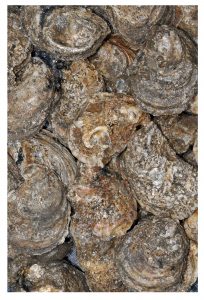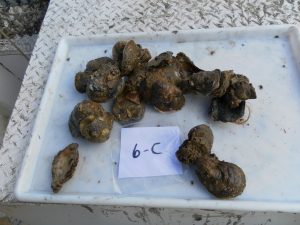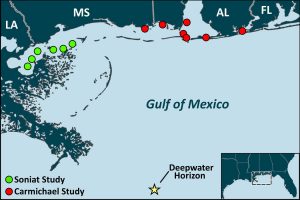Studies Indicate that Oyster Tissue and Shell were Similar in Pre- and Post- Oil Spill Conditions
– February 11, 2013
Separate groups of scientists studying the Deepwater Horizon oil spill impacts on oysters along the Gulf coast recently published their findings in two journals: the November 2012 issue of Environmental Science and Technology: Assimilation of oil-derived elements by oysters due to the Deepwater Horizon oil spill; and the December 2011 issue of Journal of Shellfish Research: Chemical and physiological measures on oysters Crassostrea virginica from oil-exposed sites in Louisiana.
Drs. Ruth Carmichael and Thomas Soniat led studies using the eastern oyster, Crassostrea virginica, as an indicator for potential oil spill effects on local food webs along Louisiana, Mississippi, and Alabama coasts. Oysters are a species of choice for ecosystem studies because they are economically and ecologically valuable to the Gulf region and because their tissue and shell act like powerful recorders of their environment.
The Soniat team looked for biological responses, such as increased susceptibility to disease and reduced reproductive capability, to hydrocarbon contaminants in oyster tissue. Researchers recorded oyster health, sex, and gonadal condition; analyzed tissue for polycyclic aromatic hydrocarbons (PAHs); and measured environmental conditions of temperature, salinity, and oxygen. The Carmichael team looked for consumption of oil-derived organic material, including six trace elements most likely to indicate exposure to oil hydrocarbons, in new shell growth of oysters as well as in their tissue. Researchers analyzed stable isotopes in oysters and in suspended particulate matter available as food and compared them with weathered and fresh oil. Neither study found evidence of oil-related contamination at levels above prior background or pre-spill conditions. Soniat’s results found that PAH levels, environmental conditions and reproductive capacity in oyster samples were similar in oiled and unoiled areas six months after the capping of the wellhead. Carmichael’s results found that oil-derived elements did not have a statistically significant influence on the stable isotope composition of oyster samples.
Soniat cautioned that his group’s results not be over applied because of the study’s spatial and temporal limitations. Carmichael suggested that her group’s findings have alternate possibilities including the oysters not consuming oil materials during their period of study or oyster samples consuming too little to detect. Both studies point to complexities in interpreting and isolating potential effects of the Deepwater Horizon oil spill.
The study authors are:
Ruth H. Carmichael, Amanda L. Jones, Heather K. Patterson, William C. Walton, Alberto Perez-Huerta, Edward B. Overton, Meghan Dailey, and Kristine L. Willett (Environmental Science & Technology 2012 46 (23), 12787-12795); and Thomas. M. Soniat, Matthew A. Tarr, and Megan A. Thorne (Journal of Shellfish Research 2011 30, (3) 713-717).
#################
This research was made possible in part by Grants from BP/The Gulf of Mexico Research Initiative (GoMRI) through the Alabama Marine Environmental Science Consortium and the Northern Gulf Institute . Other funding sources for the Carmichael, et al., study included the National Science Foundation REU program (2356JV).
The GoMRI is a 10-year independent research program established to study the effect, and the potential associated impact, of hydrocarbon releases on the environment and public health, as well as to develop improved spill mitigation, oil detection, characterization and remediation technologies. An independent and academic 20-member Research Board makes the funding and research direction decisions to ensure the intellectual quality, effectiveness and academic independence of the GoMRI research. All research data, findings and publications will be made publicly available. The program was established through a $500 million financial commitment from BP. For more information, visit https://gulfresearchinitiative.org/.
© Copyright 2010- 2017 Gulf of Mexico Research Initiative (GoMRI) – All Rights Reserved. Redistribution is encouraged with acknowledgement to the Gulf of Mexico Research Initiative (GoMRI). Please credit images and/or videos as done in each article. Questions? Contact web-content editor Nilde “Maggie” Dannreuther, Northern Gulf Institute, Mississippi State University (maggied@ngi.msstate.edu).








